engine oil levels check PEUGEOT EXPERT 2022 Owners Manual
[x] Cancel search | Manufacturer: PEUGEOT, Model Year: 2022, Model line: EXPERT, Model: PEUGEOT EXPERT 2022Pages: 324, PDF Size: 10.39 MB
Page 9 of 324
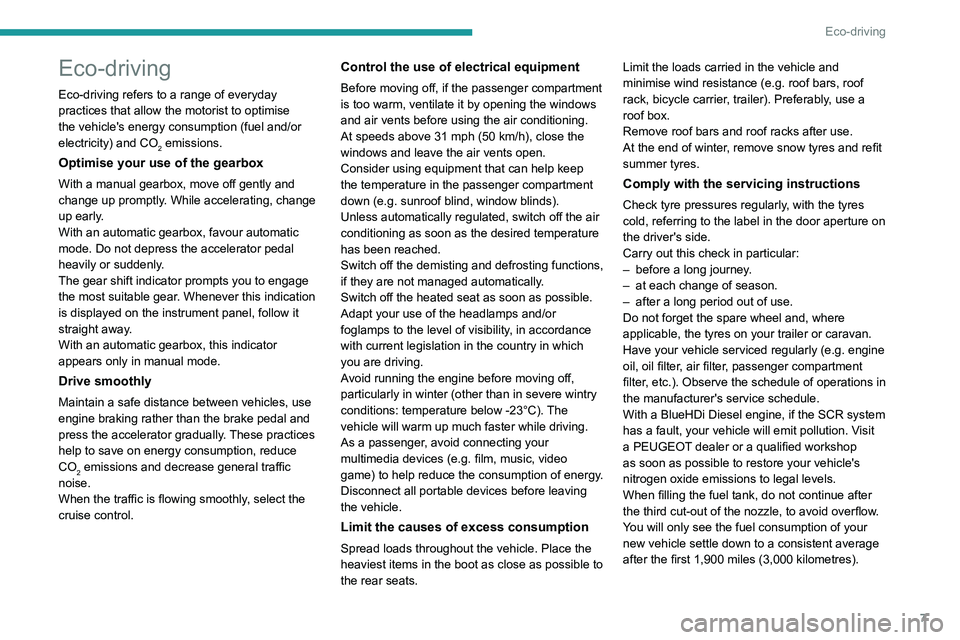
7
Eco-driving
Eco-driving
Eco-driving refers to a range of everyday
practices that allow the motorist to optimise
the vehicle's energy consumption (fuel and/or
electricity) and CO
2 emissions.
Optimise your use of the gearbox
With a manual gearbox, move off gently and
change up promptly. While accelerating, change
up early.
With an automatic gearbox, favour automatic
mode. Do not depress the accelerator pedal
heavily or suddenly.
The gear shift indicator prompts you to engage
the most suitable gear. Whenever this indication
is displayed on the instrument panel, follow it
straight away.
With an automatic gearbox, this indicator
appears only in manual mode.
Drive smoothly
Maintain a safe distance between vehicles, use
engine braking rather than the brake pedal and
press the accelerator gradually. These practices
help to save on energy consumption, reduce
CO
2 emissions and decrease general traffic
noise.
When the traffic is flowing smoothly, select the
cruise control.
Control the use of electrical equipment
Before moving off, if the passenger compartment
is too warm, ventilate it by opening the windows
and air vents before using the air conditioning.
At speeds above 31
mph (50 km/h), close the
windows and leave the air vents open.
Consider using equipment that can help keep
the temperature in the passenger compartment
down (e.g.
sunroof blind, window blinds).
Unless automatically regulated, switch off the air
conditioning as soon as the desired temperature
has been reached.
Switch off the demisting and defrosting functions,
if they are not managed automatically.
Switch off the heated seat as soon as possible.
Adapt your use of the headlamps and/or
foglamps to the level of visibility, in accordance
with current legislation in the country in which
you are driving.
Avoid running the engine before moving off,
particularly in winter (other than in severe wintry
conditions: temperature below -23°C). The
vehicle will warm up much faster while driving.
As a passenger, avoid connecting your
multimedia devices (e.g.
film, music, video
game) to help reduce the consumption of energy.
Disconnect all portable devices before leaving
the vehicle.
Limit the causes of excess consumption
Spread loads throughout the vehicle. Place the
heaviest items in the boot as close as possible to
the rear seats. Limit the loads carried in the vehicle and
minimise wind resistance (e.g.
roof bars, roof
rack, bicycle carrier, trailer). Preferably, use a
roof box.
Remove roof bars and roof racks after use.
At the end of winter, remove snow tyres and refit
summer tyres.
Comply with the servicing instructions
Check tyre pressures regularly, with the tyres
cold, referring to the label in the door aperture on
the driver's side.
Carry out this check in particular:
–
before a long journey
.
–
at each change of season.
–
after a long period out of use.
Do not forget the spare wheel and, where
applicable, the tyres on your trailer or caravan.
Have your vehicle serviced regularly (e.g.
engine
oil, oil filter, air filter, passenger compartment
filter, etc.). Observe the schedule of operations in
the manufacturer's service schedule.
With a BlueHDi Diesel engine, if the SCR system
has a fault, your vehicle will emit pollution. Visit
a PEUGEOT dealer or a qualified workshop
as soon as possible to restore your vehicle's
nitrogen oxide emissions to legal levels.
When filling the fuel tank, do not continue after
the third cut-out of the nozzle, to avoid overflow.
You will only see the fuel consumption of your
new vehicle settle down to a consistent average
after the first 1,900 miles (3,000 kilometres).
Page 20 of 324
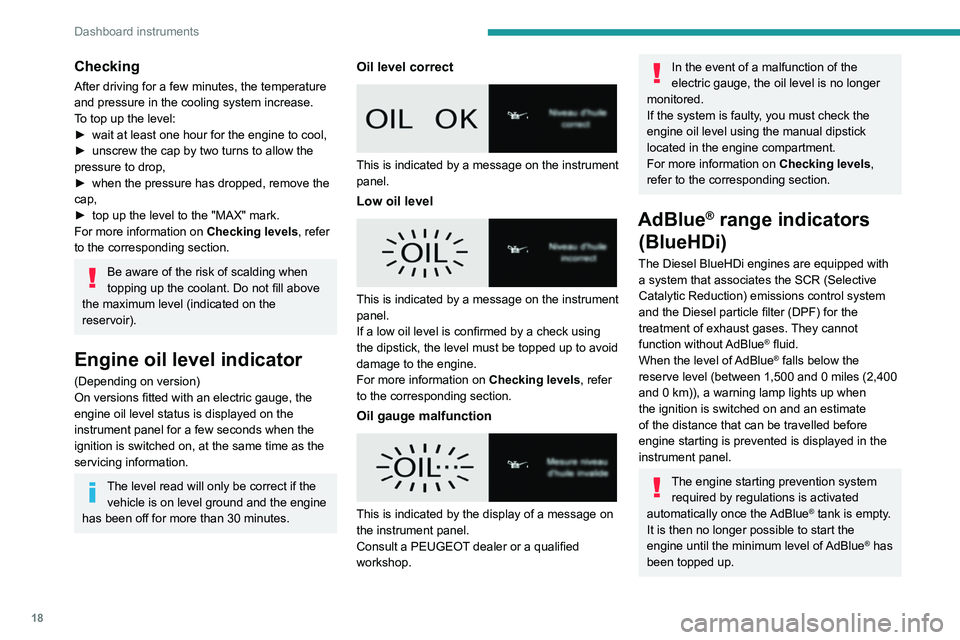
18
Dashboard instruments
Checking
After driving for a few minutes, the temperature
and pressure in the cooling system increase.
To top up the level:
►
wait at least one hour for the engine to cool,
►
unscrew the cap by two turns to allow the
pressure to drop,
►
when the pressure has dropped, remove the
cap,
►
top up the level to the "MAX" mark.
For more information on Checking levels
, refer
to the corresponding section.
Be aware of the risk of scalding when
topping up the coolant. Do not fill above
the maximum level (indicated on the
reservoir).
Engine oil level indicator
(Depending on version)
On versions fitted with an electric gauge, the
engine oil level status is displayed on the
instrument panel for a few seconds when the
ignition is switched on, at the same time as the
servicing information.
The level read will only be correct if the vehicle is on level ground and the engine
has been off for more than 30 minutes.
Oil level correct
This is indicated by a message on the instrument
panel.
Low oil level
This is indicated by a message on the instrument
panel.
If a low oil level is confirmed by a check using
the dipstick, the level must be topped up to avoid
damage to the engine.
For more information on Checking levels, refer
to the corresponding section.
Oil gauge malfunction
This is indicated by the display of a message on
the instrument panel.
Consult a PEUGEOT dealer or a qualified
workshop.
In the event of a malfunction of the
electric gauge, the oil level is no longer
monitored.
If the system is faulty, you must check the
engine oil level using the manual dipstick
located in the engine compartment.
For more information on Checking levels,
refer to the corresponding section.
AdBlue® range indicators
(BlueHDi)
The Diesel BlueHDi engines are equipped with
a system that associates the SCR (Selective
Catalytic Reduction) emissions control system
and the Diesel particle filter (DPF) for the
treatment of exhaust gases. They cannot
function without AdBlue
® fluid.
When the level of AdBlue® falls below the
reserve level (between 1,500 and 0 miles (2,400
and 0
km)), a warning lamp lights up when
the ignition is switched on and an estimate
of the distance that can be travelled before
engine starting is prevented is displayed in the
instrument panel.
The engine starting prevention system required by regulations is activated
automatically once the AdBlue
® tank is empty.
It is then no longer possible to start the
engine until the minimum level of AdBlue
® has
been topped up.
Page 194 of 324
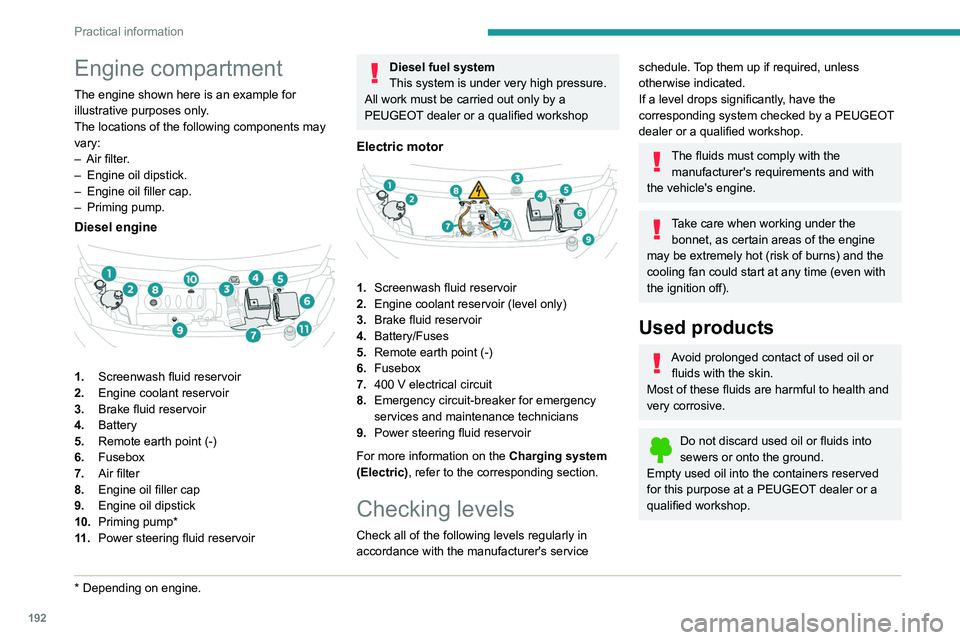
192
Practical information
Engine compartment
The engine shown here is an example for
illustrative purposes only.
The locations of the following components may
vary:
–
Air filter
.
–
Engine oil dipstick.
–
Engine oil filler cap.
–
Priming pump.
Diesel engine
1. Screenwash fluid reservoir
2. Engine coolant reservoir
3. Brake fluid reservoir
4. Battery
5. Remote earth point (-)
6. Fusebox
7. Air filter
8. Engine oil filler cap
9. Engine oil dipstick
10. Priming pump*
11 . Power steering fluid reservoir
* Depending on engine.
Diesel fuel system
This system is under very high pressure.
All work must be carried out only by a
PEUGEOT dealer or a qualified workshop
Electric motor
1. Screenwash fluid reservoir
2. Engine coolant reservoir (level only)
3. Brake fluid reservoir
4. Battery/Fuses
5. Remote earth point (-)
6. Fusebox
7. 400
V electrical circuit
8. Emergency circuit-breaker for emergency
services and maintenance technicians
9. Power steering fluid reservoir
For more information on the Charging system
(Electric), refer to the corresponding section.
Checking levels
Check all of the following levels regularly in
accordance with the manufacturer's service
schedule. Top them up if required, unless
otherwise indicated.
If a level drops significantly, have the
corresponding system checked by a PEUGEOT
dealer or a qualified workshop.
The fluids must comply with the manufacturer's requirements and with
the vehicle's engine.
Take care when working under the bonnet, as certain areas of the engine
may be extremely hot (risk of burns) and the
cooling fan could start at any time (even with
the ignition off).
Used products
Avoid prolonged contact of used oil or fluids with the skin.
Most of these fluids are harmful to health and
very corrosive.
Do not discard used oil or fluids into
sewers or onto the ground.
Empty used oil into the containers reserved
for this purpose at a PEUGEOT dealer or a
qualified workshop.
Page 291 of 324
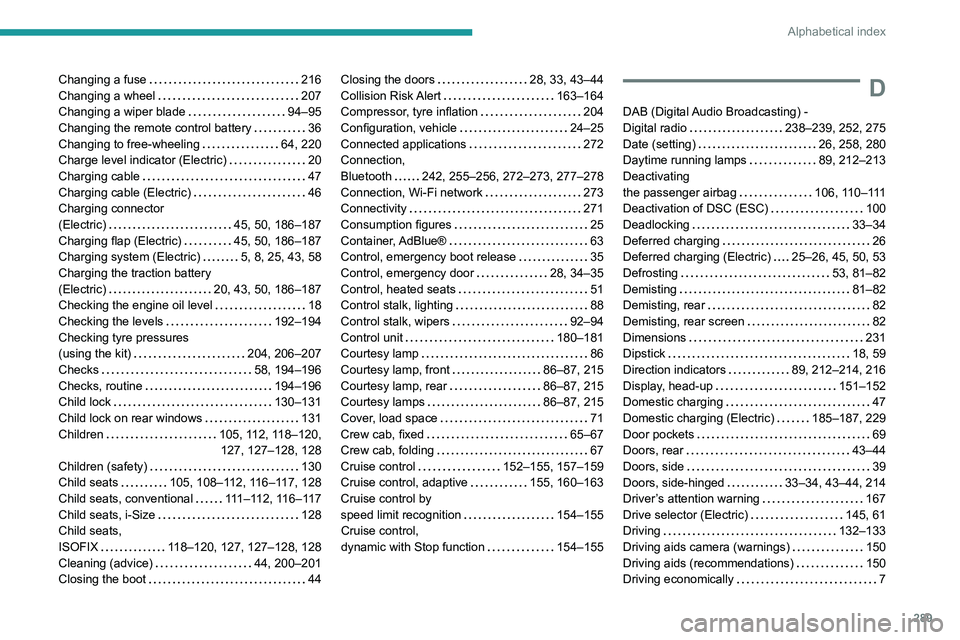
289
Alphabetical index
Changing a fuse 216
Changing a wheel
207
Changing a wiper blade
94–95
Changing the remote control battery
36
Changing to free-wheeling
64, 220
Charge level indicator (Electric)
20
Charging cable
47
Charging cable (Electric)
46
Charging connector
(Electric)
45, 50, 186–187
Charging flap (Electric)
45, 50, 186–187
Charging system (Electric)
5, 8, 25, 43, 58
Charging the traction battery
(Electric)
20, 43, 50, 186–187
Checking the engine oil level
18
Checking the levels
192–194
Checking tyre pressures
(using the kit)
204, 206–207
Checks
58, 194–196
Checks, routine
194–196
Child lock
130–131
Child lock on rear windows
131
Children
105, 112, 118–120, 127, 127–128, 128
Children (safety)
130
Child seats
105, 108–112, 116–117, 128
Child seats, conventional
111–112, 116–117
Child seats, i-Size
128
Child seats,
ISOFIX
118–120, 127, 127–128, 128
Cleaning (advice)
44, 200–201
Closing the boot
44Closing the doors 28, 33, 43–44
Collision Risk Alert
163–164
Compressor, tyre inflation
204
Configuration, vehicle
24–25
Connected applications
272
Connection,
Bluetooth
242, 255–256, 272–273, 277–278
Connection, Wi-Fi network
273
Connectivity
271
Consumption figures
25
Container, AdBlue®
63
Control, emergency boot release
35
Control, emergency door
28, 34–35
Control, heated seats
51
Control stalk, lighting
88
Control stalk, wipers
92–94
Control unit
180–181
Courtesy lamp
86
Courtesy lamp, front
86–87, 215
Courtesy lamp, rear
86–87, 215
Courtesy lamps
86–87, 215
Cover, load space
71
Crew cab, fixed
65–67
Crew cab, folding
67
Cruise control
152–155, 157–159
Cruise control, adaptive
155, 160–163
Cruise control by
speed limit recognition
154–155
Cruise control,
dynamic with Stop function
154–155D
DAB (Digital Audio Broadcasting) -
Digital radio
238–239, 252, 275
Date (setting)
26, 258, 280
Daytime running lamps
89, 212–213
Deactivating
the passenger airbag
106, 110–111
Deactivation of DSC (ESC)
100
Deadlocking
33–34
Deferred charging
26
Deferred charging (Electric)
25–26, 45, 50, 53
Defrosting
53, 81–82
Demisting
81–82
Demisting, rear
82
Demisting, rear screen
82
Dimensions
231
Dipstick
18, 59
Direction indicators
89, 212–214, 216
Display, head-up
151–152
Domestic charging
47
Domestic charging (Electric)
185–187, 229
Door pockets
69
Doors, rear
43–44
Doors, side
39
Doors, side-hinged
33–34, 43–44, 214
Driver’s attention warning
167
Drive selector (Electric)
145, 61
Driving
132–133
Driving aids camera (warnings)
150
Driving aids (recommendations)
150
Driving economically
7
Page 293 of 324
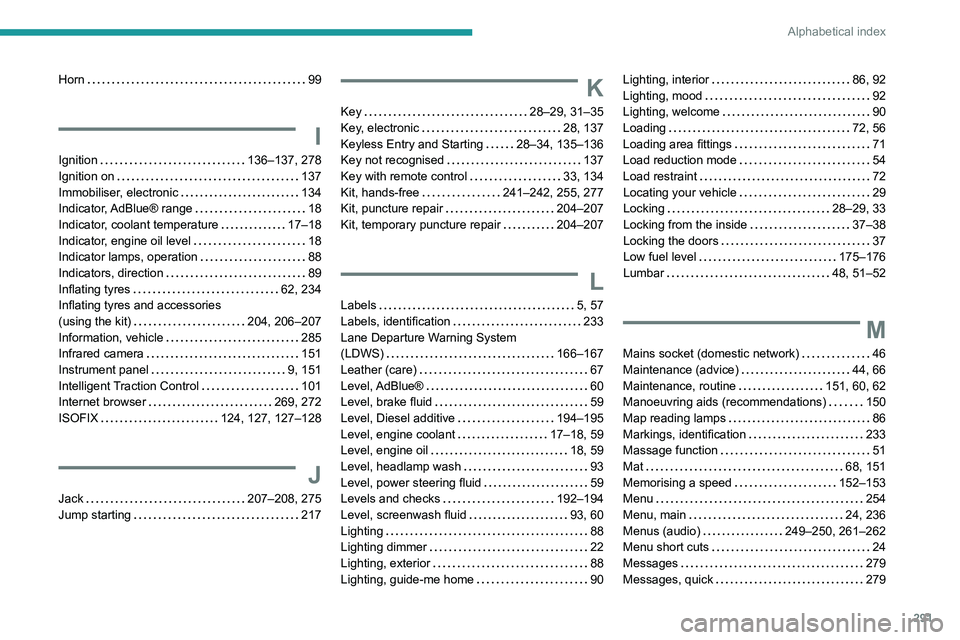
291
Alphabetical index
Horn 99
I
Ignition 136–137, 278
Ignition on
137
Immobiliser, electronic
134
Indicator, AdBlue® range
18
Indicator, coolant temperature
17–18
Indicator, engine oil level
18
Indicator lamps, operation
88
Indicators, direction
89
Inflating tyres
62, 234
Inflating tyres and accessories
(using the kit)
204, 206–207
Information, vehicle
285
Infrared camera
151
Instrument panel
9, 151
Intelligent Traction Control
101
Internet browser
269, 272
ISOFIX
124, 127, 127–128
J
Jack 207–208, 275
Jump starting
217
K
Key 28–29, 31–35
Key, electronic
28, 137
Keyless Entry and Starting
28–34, 135–136
Key not recognised
137
Key with remote control
33, 134
Kit, hands-free
241–242, 255, 277
Kit, puncture repair
204–207
Kit, temporary puncture repair
204–207
L
Labels 5, 57
Labels, identification
233
Lane Departure Warning System
(LDWS)
166–167
Leather (care)
67
Level, AdBlue®
60
Level, brake fluid
59
Level, Diesel additive
194–195
Level, engine coolant
17–18, 59
Level, engine oil
18, 59
Level, headlamp wash
93
Level, power steering fluid
59
Levels and checks
192–194
Level, screenwash fluid
93, 60
Lighting
88
Lighting dimmer
22
Lighting, exterior
88
Lighting, guide-me home
90
Lighting, interior 86, 92
Lighting, mood
92
Lighting, welcome
90
Loading
72, 56
Loading area fittings
71
Load reduction mode
54
Load restraint
72
Locating your vehicle
29
Locking
28–29, 33
Locking from the inside
37–38
Locking the doors
37
Low fuel level
175–176
Lumbar
48, 51–52
M
Mains socket (domestic network) 46
Maintenance (advice)
44, 66
Maintenance, routine
151, 60, 62
Manoeuvring aids (recommendations)
150
Map reading lamps
86
Markings, identification
233
Massage function
51
Mat
68, 151
Memorising a speed
152–153
Menu
254
Menu, main
24, 236
Menus (audio)
249–250, 261–262
Menu short cuts
24
Messages
279
Messages, quick
279